Art & Exhibitions
New Museum Wrestles with Jim Shaw’s Fascinating Fanaticism
It's a deliberately cultivated form of taste.
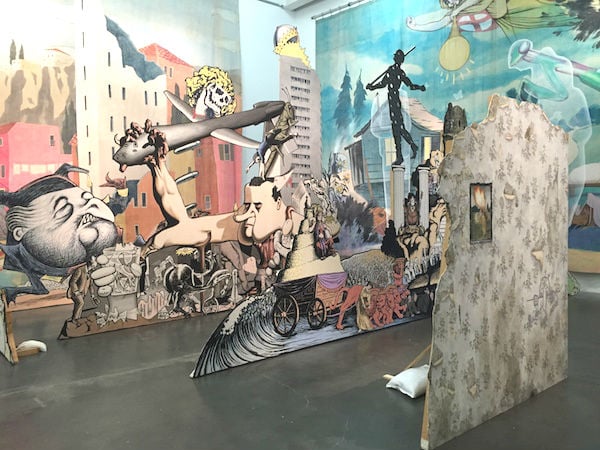
It's a deliberately cultivated form of taste.

Ben Davis

It may not be fair, but Jim Shaw lives in the shadow of two better known giants of the Los Angeles scene, who come up in every review: Paul McCarthy, whose spectacular creepshow art, curdled with pop culture, offers thematic similarities to Shaw’s eerie psychosexual drawings and installations; and particularly the late, great Mike Kelley, with whom he founded the experimental rock band Destroy All Monsters as a student, and shared any number of other obsessions (including a very conspicuous Superman fetish).
But what strikes me about “The End Is Here,” Shaw’s current retrospective at the New Museum in New York, curated by Massimiliano Gioni, Gary Carrion-Muriyari, and Margot Norton, is how different the artist’s sensibility seems beneath the clear-cut similarities. Born in Michigan in 1952 and trained at CalArts in its experimental ‘70s heyday, Shaw’s multiform corpus is more sweet-tempered, more introverted, less sadistic. This makes him feel less edgy—but that very fact encodes a certain moral about the art of transgression.
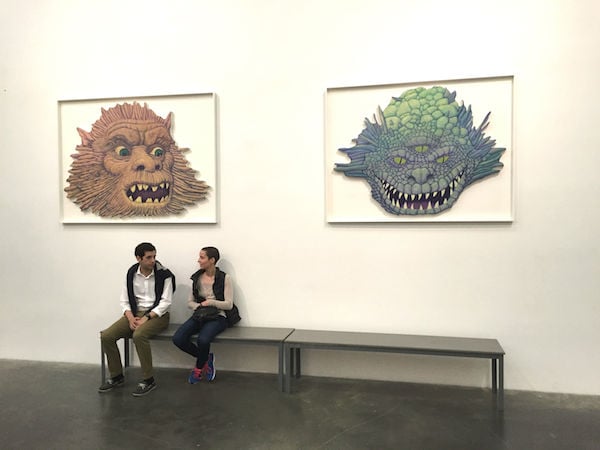
Jim Shaw’s Dream Object (“A couple of Vegas students…”)(2000) in “The End Is Here” at the New Museum.
Photo: Ben Davis.
Kelley and McCarthy pioneered an art of aggro abjection, rubbing the viewer’s face in puke, terror, and taboo sexual fantasy with a punk zeal that Shaw’s work mainly lacks. The more aggressive sensibility seems rooted in a shared experience of repressive religious authority: Kelley’s early Catholicism, and McCarthy’s boyhood in Mormon Salt Lake City. For each with their different emphases, flushing the repressed to the surface has a viscerally satisfying anti-establishment charge.
Here’s Shaw on his own background, in an interview with Gioni in the current show’s catalogue:
As far as religion goes, I was raised as an Episcopalian, but a lot of my friends were Catholics, including Mike Kelley. And that Catholic stuff seemed a lot more interesting, even though mainstream religion was kind of boring back in those days. There was a certain knee-jerk reaction in those early pieces: I think I was pretending to be a rebellious Catholic. But I was an Episcopalian, and we didn’t even have a pope.
Such a confession may reinforce the sense that he stands as simply the diet version of Mike Kelley. But there’s a way that this different starting point makes him more of a complement to Kelley than an inferior copy: Instead of being about Normal America’s repression of the weird, Shaw’s art is about Normal America’s longing for the weird.
Really thinking about this subtle difference of emphasis helps dispel some common misconceptions about Shaw.
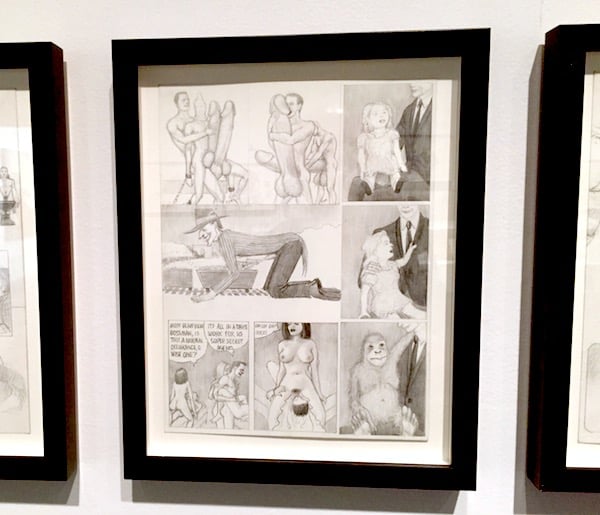
One of Jim Shaw’s “Dream Drawings” from “The End Is Here.”
Photo: Ben Davis.
In the New Museum show, the second floor focuses on works like Shaw’s long-running comic book-style pencil drawings of his dreams and “My Mirage,” a lengthy, multipart artwork, executed in a variety of styles, that serves as a kind of biography of a character named “Jimmy” as he endures the confusions of coming of age in the 1960s. The fifth floor centers on large, free-standing paintings resembling stage-set backdrops, replete with references to Picasso’s Guernica and Casper the Friendly Ghost—maniacal though strangely genial portraits of civilization in psychic free-fall.
The most interesting floor—the meat in the Jim Shaw sandwich, if you will—is the third, which focuses on his obsessive collecting of various kinds, a practice which he has pursued with such an intensity that it has assumed the status of a parallel art practice. Here, evidence of his collecting both gives a hint into his inspirations and serves as a kind of psychic key to the rest of his work.
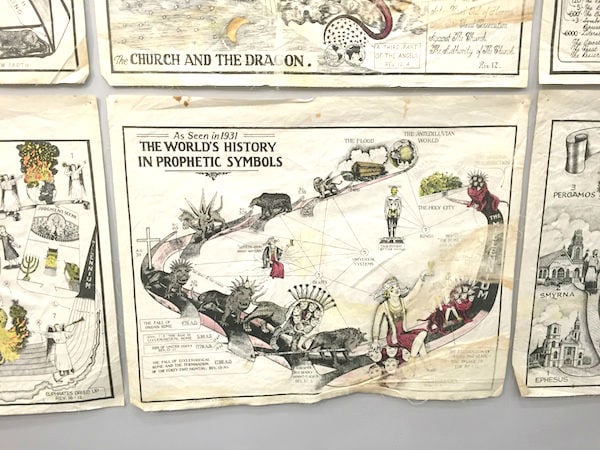
Detail of “The Hidden World.”
Photo: Ben Davis.
One gallery, dubbed “The Hidden World,” assembles Shaw’s trove of pamphlets, paintings, banners, and books from various religions, para-religions, cults, and sects: Mormons, Scientologists, Freemasons, and fringe groups. Presented almost without comment, this thicket of wild-eyed conspiracy theories, overheated rhetoric, and comic-book fantasies of the Mother of Harlots and the End of Days forms a deadpan cabinet of religious curiosities.
In an essay in the catalogue, Marc Olivier-Wahler interprets this material’s significance: “[B]y discouraging all attempts to adopt an interpretive system at the expense of another (that of the art world, for example), [“The Hidden World”] instead encourages the public to embrace a perspective of our world completely free of any impulses to create hierarchies.” As with almost all claims about transcending all hierarchy, this statement is deceptive.
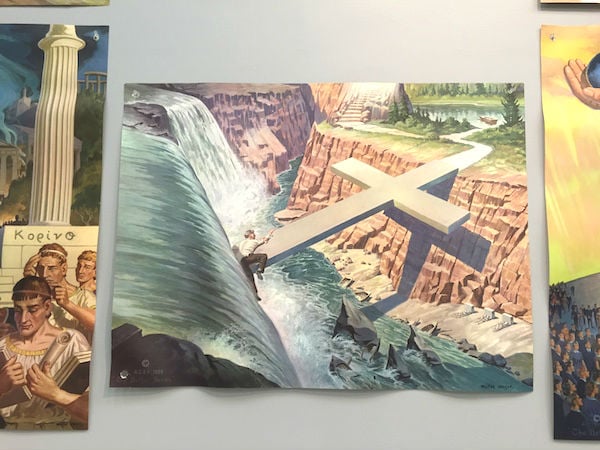
Walter H. Ohlson painting, featured in Jim Shaw’s “The Hidden World” at the New Museum.
Photo: Ben Davis.
“The Hidden World” paraphernalia itself may be presented without judgment of priority—but it is very clearly not presented by a believer, or for the community of believers. Shaw once described his own religious background as “this neutered version of Catholicism without all the crazy stuff.”
“The Hidden World” stands as testimony to a fascination with exactly “the crazy stuff” of religion from someone who feels their own symbolic universe is relatively “neutered” of its spooky enchantments. It offers the contact high of extravagant fanaticism without smoking the real thing.
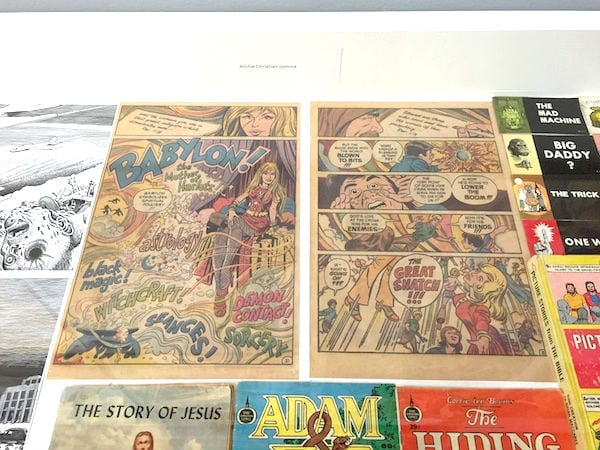
Installation detail of Jim Shaw’s “The Hidden World,” featuring “Archie Christian comics.”
Photo: Ben Davis.
Adjacent to this, one finds another long-running collection of Shaw’s: “Thrift Store Paintings.” These are amateur paintings culled from various garage sales and low-level auctions over the course of decades, often attributed to anonymous sources. Hung here in a dense salon style, they read as a thoroughly charming collection of oddities, conspicuous for its accidental surrealism.
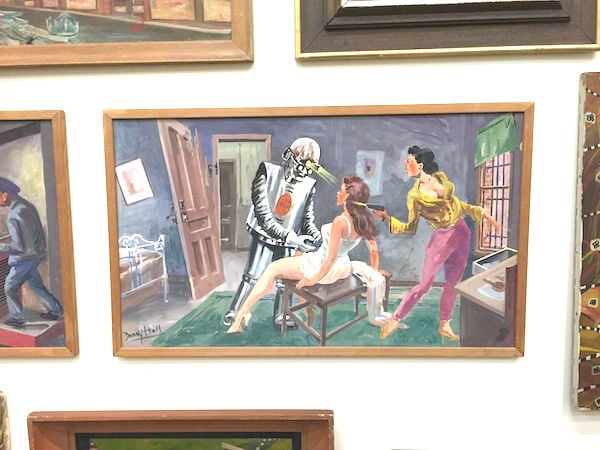
Installation shot of “Thrift Store Paintings” at the New Museum.
Photo: Ben Davis.
One tendency in writing about the “Thrift Store Paintings” has been to assert that they provide a glimpse into the repressed obsessions of the collective psyche; as Shaw himself puts it, “these paintings to me were bits of the American subconscious.”
However, this line also strikes me as off; the American subconscious, as surveyed via its actual thrift stores, would obviously be a lot less interesting than what we see here. For every one unnervingly sexualized Tinker Bell there would be dozens of plain-old leafy landscapes; for every humorously botched piece like the one that Shaw laconically and accurately titles Man with No Crotch Sits Down With Girl, there would be dozens of perfectly banal figure drawings.
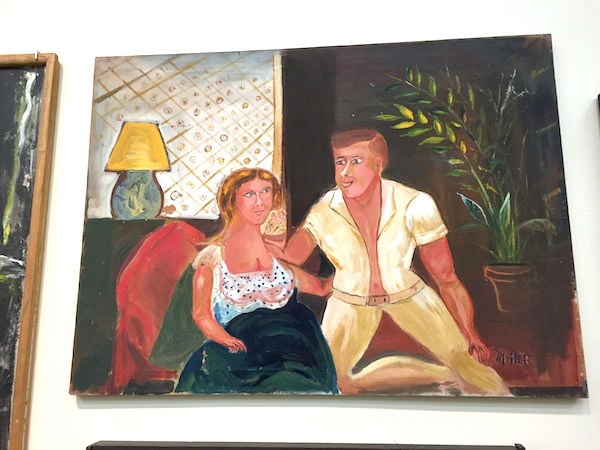
Miler, Man with No Crotch Sits Down With Girl (n.d.) in Jim Shaw’s “Thrift Store Paintings.”
Photo: Ben Davis.
“I’m obviously going toward the nightmarish and the perverse, as well as the charming mistake,” the catalogue quotes Shaw explaining. To the Guardian, he further elaborated, “A lot of the more surrealist and expressionist paintings among them involve some sort of sinful activity. There seems to be a lot of puritanism, shame and guilt involved.”
Confronted with Salvador Dali’s painting, Sigmund Freud once supposedly said that he didn’t see the “unconscious” in them, only Dali’s conscious mind. “Your mystery is manifested outright,” Freud remarked. “The picture is but a mechanism to reveal it.” The “mechanism” is different, but the quip remains true here.
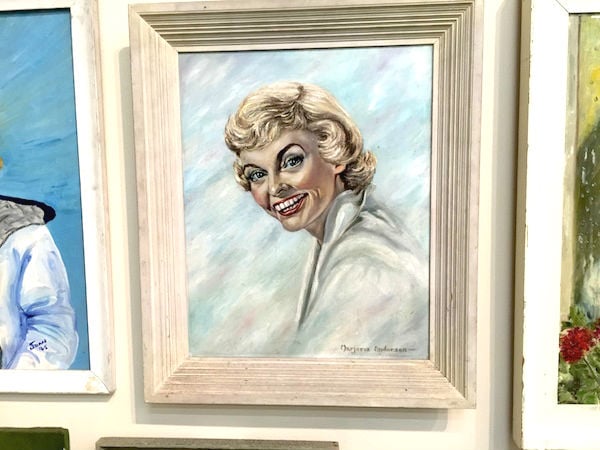
Anonymous, Psycho Lady in “Thrift Store Paintings.”
Photo: Ben Davis.
What the “Thrift Store Paintings” represent is not the unspoken American subconscious, but a deliberately cultivated form of taste. These days, an appreciation for offbeat camp is at least as important, culturally, as a taste for beauty, from The Room to Sharknado, so you could say Shaw’s strange act of connoisseurship has been prophetic.
Overall, “The End Is Here” illustrates that Shaw has, without doubt, carved his own world out of the same kinds of testosterone-laced, Baby Boomer obsessions (e.g., ’50s monster movies, comic books) from which Kelley or McCarthy spun their dark magic. It is true that Shaw’s world feels more cautious, more introspective, and more diffuse than that of his peers—but then this aesthetic demerit may in fact be a philosophical strength. By disposition, Shaw better reflects the Mobius-strip like structure of contemporary culture, where a taste for the outsider becomes not a marker of the mad, the bad, and the abject, but of a kind of sophistication.
Jim Shaw, “The End Is Here,” is on view at the New Museum through January 10, 2016.